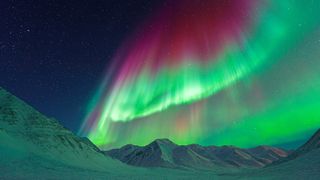NASA set to launch 2 rockets into the northern lights
Researchers plan to measure winds, temperatures and densities within the aurora.

Researchers plan to launch two rockets into the heart of the northern lights.
The launch window for NASA's Ion-Neutral Coupling during Active Aurora mission opened Wednesday (March 23) and runs through April 1; another window is open from April 3–7. The Wednesday launch was scrubbed due to bad weather.
Led by Clemson University astronomer Stephen Kaeppler, scientists hope to send two rockets loaded with sensing tools into the active aurora borealis. They plan to measure the winds, temperatures and densities of the plasma within the aurora.
The dancing lights of the aurora form when charged particles from space crash into molecules in Earth's upper atmosphere. These collisions boost the energy of the electrons in these atmospheric molecules, causing the electrons to orbit their nuclei at a higher energy state. When the buzz wears off, the electrons drop back down to their original energy state, releasing a photon, or particle of light, as they do so. These photons create the shifting curtains of green, violet and red seen at polar latitudes.
Kaeppler and his team are interested in the boundary between neutral gases in the atmosphere and plasma, or charged gas that becomes increasingly prevalent in the upper atmosphere. The molecular disturbance of the aurora perturbs the boundary layer between lower-atmosphere neutral gases and higher-atmosphere plasma. The disturbance leads to friction and, therefore, heat that researchers can measure.

"We all know that [if] we rub our hands together, you're going to get heat," Kaeppler said in a statement. "It's the same basic idea, except we're dealing with gases now instead."
The first of the team's rockets will release colorful vapors as it travels to a height of 186 miles (299 kilometers). These vapors, similar to the chemicals that make fireworks colorful, will drift in the atmosphere, allowing researchers to trace atmospheric wind. The next rocket is designed to reach a peak height of 125 miles (201 km) in order to carry instruments to measure temperature and density within the aurora. The rockets will fall back to Earth immediately after making their measurements.
Sign up for the Live Science daily newsletter now
Get the world’s most fascinating discoveries delivered straight to your inbox.
The results should reveal the details of how the aurora alters that boundary layer between neutral gas and plasma, Kaeppler said in the statement. The boundary might get higher, drop lower, or fold and change shape.
"All of these factors make this an interesting physics problem to examine," Kaeppler said.
The rockets launched from the Poker Flat Research Range north of Fairbanks, Alaska.
Originally published on Live Science.
Editor's note: This article was updated to indicate the Wednesday (March 23) launch was scrubbed due to weather.

Stephanie Pappas is a contributing writer for Live Science, covering topics ranging from geoscience to archaeology to the human brain and behavior. She was previously a senior writer for Live Science but is now a freelancer based in Denver, Colorado, and regularly contributes to Scientific American and The Monitor, the monthly magazine of the American Psychological Association. Stephanie received a bachelor's degree in psychology from the University of South Carolina and a graduate certificate in science communication from the University of California, Santa Cruz.
